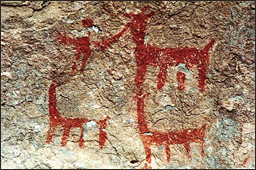
The Rock Art Site of Calacala, Bolivia. Credit: http://www.bradshawfoundation.com/bolivia/calacala.php
This week’s research seminar was presented by Dr. Penny Dransart on the development and continuation of the pastoral care of camelids in the Chilean Andes over the last several thousand years. The high altitudes and steppe regions of these mountains make them largely unsuitable for the cultivation of crops, so nomadic herding is the main subsistence that can be sustained here. Penny’s work explores the long-term continuity of herding practices and the use of pastures to keep camelid herds through exploration of the ethnographic and archaeological records, as well as a broad brush approach to understanding camelids.
Her talk began discussing the fascinating social dynamics and esoteric knowledge that is essential to these pastoralists for maximising their use of the landscape, especially when the area is struck by extreme seasonal phenomena, such as aridity. Only with an acute awareness of the landscape they inhabit do people in this region know where to go and how to survive.
Other key features included the adaptation of llamas to the mountainous terrain and how the animals were exploited by the herders. For instance, unlike the pastoral care of cattle in African tribes, the milking of llamas is rarely, if ever, undertaken, with herds kept for their fleeces and for meat. Certain breeds, such as guanacos, possess such elegant fleeces they might be more likely to be kept for this reason. At Tulan, intricate weaving practices and yarnwork were recovered from the midden deposits.
Penny demonstrated how the visual interest in camelids is sustained over time throughout the region and further afield. Rock carvings and cave art are numerous, such as at the site of Taira, while the later Wari Culture produced ceramic representations of these creatures.
Overall, Penny showed how the relationship between herders and their herds is much more socially charged than one might expect. The continuity of herding practices over a long expanse of time and the dynamics inherent to pastoralism mean that an inherent link is held between the society and their animals. Overall a great insight into the cultural relationships between people and camelids and the fascinating ongoing research in the area.
Written by Matt Knight.
